
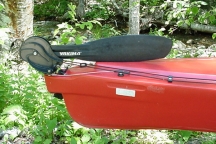 How To Install A Rudder
How To Install A Rudder
On A Sit-on-top Kayak by Tom Holtey
This article was originally written as a supplement to the Yakima/Perception
rudder instructions in 2001. The Yakima Rudder Kit is no longer available. If necessary use the BTS Replacement Rudder Assembly.
The BTS Rudder Kit for solo kayaks is the current rudder kit for all Aquaterra, Perception and Dagger kayaks. This article is completely applicable to the new kit, covering the rear hatch & center hatch differences found in the Illusion & Prism kayaks. This page will provide insight into rudder installation for other kayak brands.

 This article is meant to be a supplement to the current BTS rudder kit instructions as they apply to the Perception Illusion & Aquaterra Prism. The rudder & the kayak are fairly common in design to other makes & models. As such the principles can be applied to many other kayak rudder installations. See the Related Articles links below for more info that applies to other kayaks and SOTs with a cargo tank well on back. There are references to parts & procedures found only in the old Yakima Rudder kit & instructions that can be ignored. This page will also be of use in repair of original parts.
This article is meant to be a supplement to the current BTS rudder kit instructions as they apply to the Perception Illusion & Aquaterra Prism. The rudder & the kayak are fairly common in design to other makes & models. As such the principles can be applied to many other kayak rudder installations. See the Related Articles links below for more info that applies to other kayaks and SOTs with a cargo tank well on back. There are references to parts & procedures found only in the old Yakima Rudder kit & instructions that can be ignored. This page will also be of use in repair of original parts.
When applied to the Aquaterra Prism you will need the "Chinook" Perception Rudder Casting in order to complete the rudder parts kit. The "Chinook" Perception Rudder Casting fits most older Aquaterra and Perception brand kayaks, circa 1990s.
Adding a rudder to your kayak can be a daunting task, but with an aptitude for assembly and some careful work it can be done in a do-it-yourself manner for those who purchased a boat without a rudder and then decided they wanted one after all. Some kayak shops may have the skill to do this job for you as an alternative. You may want to read "When to get a Rudder & How to use it" for additional information.
We felt that our Perception Illusion could benefit from a rudder. While not mandatory, once we did get a rudder on the Illusion we certainly did appreciate the added control. We obtained our rudder through Perception Kayaks (Harmony is their accessory division) and it came with the Yakima logo. It was well packaged, looked strong with plenty of extra parts and hardware. Also of note: the instructions are very good with nice diagrams.
| Check Tools | Lay Out Line | Rudder Knot | Drilling Holes | Tubing |
| Rudder Hook | Install Foot Pegs | Crimp Swage | Test Your Work | RESOURCES |
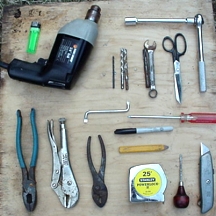
 Check
Your Tools
Check
Your Tools
The first thing to do is to thoroughly read through the instructions, using this supplement as necessary.
Next assemble all your tools. The instructions include a tool list. Then take a careful look at the parts and sort them.
Check to make sure that you have them all. I did add a couple tools to the list and a few extra parts, more on that as we go along.
Take a careful look at your drill bits. Not all the bits needed are a common size. While you may be able to "fudge" on the correct drill bit size I would highly recommend that you do invest in the right ones. Not only will you reduce leaking, make the job go easier but also new sharp bits are nice to work with.
Set up "shop" by placing the kayak on a bench, table or saw horses, blocked so the kayak cannot rock. Having the kayak at a comfortable level is important, not too high or low.
The kayak itself will offer places to hold the hardware and tools as you do your job.
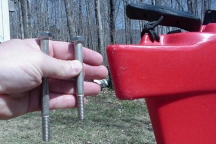
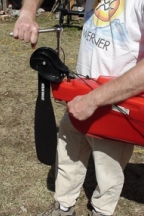 My
kit came with two rudder bolts one short and one long (rudder kit is
for Dagger kayaks also.) The short one looks good, but you need to use
the long bolt.
My
kit came with two rudder bolts one short and one long (rudder kit is
for Dagger kayaks also.) The short one looks good, but you need to use
the long bolt.
The directions are not clear on this, but they need not be, the short bolt is too short.
The diagram provided will clue you in on the washers and bushings very clearly.
Tighten the bolt, but not too tight, to allow the rudder freedom of movement.
On the Illusion you will want to remove the hatch straps so you can add cable holders on top of them. This will save drilling new holes and make for a clean install. You may need to use longer screws to accept the additional hardware.
The instructions may suggest the use of the cap nuts, but feel free to use the well-nuts that are already in use in these spots.
In fact if you have extra well-nuts I would suggest their use, other wise the cap nuts will do. One could also use rivets in place of stainless screws and well-nuts if they felt so inclined.
Lay Out The Line
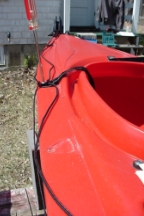
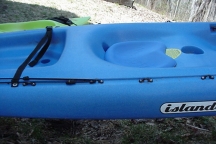 Layout
the line carefully and plan where to place the rear cable holder. Make
sure that the lines will not interfere with any thing. Look for a tiny
mark molded into the plastic; a circle or triangle or both. That mark
is in a good spot. Once you have located the mark you can drill it.
Layout
the line carefully and plan where to place the rear cable holder. Make
sure that the lines will not interfere with any thing. Look for a tiny
mark molded into the plastic; a circle or triangle or both. That mark
is in a good spot. Once you have located the mark you can drill it.
Next task it to place the deck loop for the lift line. The instructions provided detail a sit-in-side kayak. So, it is not entirely clear for sit-on-top applications, but the principle can be applied.
I took a careful look at my Islander Ventura (yet another member of the Perception family of companies) as a guide. If you have access to a Perception sit-on with a rudder you should have a good look at it. You will also see that the Illusion has two tiny marks molded in the correct place to locate this deck loop. Use them as a drill guide and fasten the deck loop.
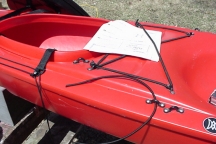
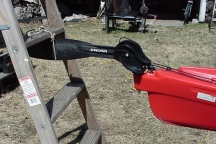 Rudder
Knot
Rudder
Knot
Next step is to tie the rudder knot. The rudder needs to be lifted in a strait out position.
I tied mine to a ladder that was at the right height. Any thing you can tie off to or prop up on will work, as well a partner willing to hold while you tie the rudder knot.
The directions are fairly clear, and the knot diagram looks good, but I did have a little trouble.
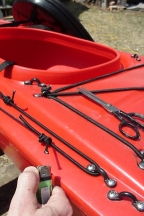
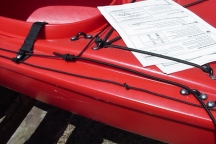 Firstly
I am not a knot person and had a bit of difficulty in getting the knot
right.
Firstly
I am not a knot person and had a bit of difficulty in getting the knot
right.
Secondly I had a bit of trouble in locating the exact position of the knots on the line.
After several attempts of getting the knot right, but in the wrong place, I finally "marked" the right spot on the line with a simple overhand knot.
Using the knot diagram of the rudder knot with the overhand in the center, I ended up with a slightly larger knot. Non-the-less I believe there is some room for "alternative" knot tying as desired.
The main purpose of the knots is to find, grab, and pull the lift line to raise or lower the rudder.
There will be some extra cord from the lift line, unless you are mounting to a much longer kayak. Any extra line can be trimmed with sharp scissors or knife. Melt the cut end with a lighter to prevent it from fraying. Keep the extra cord it may come in handy.
Drilling Holes
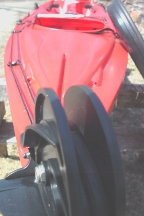
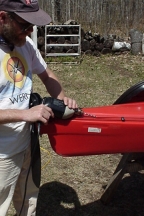 While
drilling the rudder cable exit holes I discovered that this step would
best be done before hanging the rudder assembly (first step). The reason
for this is that the rudder actually is in the way of the drill. Non-the-less
there is a bit of angle needed, and I managed just fine.
While
drilling the rudder cable exit holes I discovered that this step would
best be done before hanging the rudder assembly (first step). The reason
for this is that the rudder actually is in the way of the drill. Non-the-less
there is a bit of angle needed, and I managed just fine.
The directions for drilling the exit holes outline three ways, including the method for installing this rudder on a Prism, the predecessor of the Illusion; but you will need a special rudder mount casting if mounting on a Prism. E-mail Tom or Perception for details.
The next step is to insert the black plastic tubing that the rudder cable runs through. It will likely be all in one piece. If so, simply find the center point and cut it in two with a sharp knife.
The diagrams and instructions included will once again feature sit-in-sides, making it necessary to "interpret" the directions onto "sit-on-top." Ignore the discussion of bulkheads and where to attach the tubing inside the cockpit.
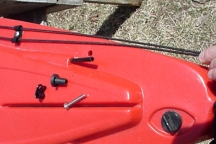
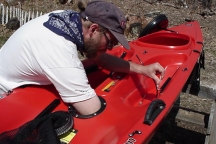 Tubing
Tubing
On a standard Illusion, with center hatch, you can insert the black tubing out of the exit holes from the inside of the kayak reaching through the large rear hatch. This may be trouble if you have short arms (mine are not long, but I managed) but will save you from having the push and pull the entire length of the tube through the hole. This should be applicable to other kayaks as well.
Also of note: There must be a center hatch installed in the kayak to allow for you to insert the tubing out through the front holes, (more below) other wise you will have to insert the entire tube into the front holes first, then pulling the tube through the hull and push out the exit hole at the stern, all by reaching into the large rear hatch.
If your kayak does not have a center hatch and you wish to add one; Cut the hatch opening into the cockpit first, install the rudder cable tubes, and them finish the hatch job. This way the opening to access will be larger and easier to use. Contact Tom about center hatches if needed.
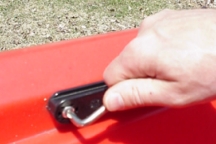
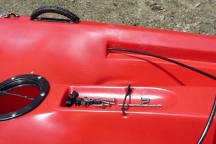 Remove
the foot peg tracks from the top of the footwells. Perception calls
them "Keepers." You will need a 90 degree screw driver to
do this.
Remove
the foot peg tracks from the top of the footwells. Perception calls
them "Keepers." You will need a 90 degree screw driver to
do this.
Your rudder kit will likely come with new tracks and foot pegs. Use them, and set aside your old ones for spare parts. (more about that below)
There will be no instructions for drilling the front cable tube holes on sit-on-top boats. Fear not! There will be tiny marks molded on the back end of the slots at the top of the footwells where the foot peg tracks are bolted. Drill the holes where these marks are, or just a bit out-board is better.
Slip the tubing that is inside the rear cargo hold along the outboard edge inside the area that is next to the seat. Then reach into the open center hatch, find the tube and insert into and out of the hole drilled in the cockpit. This is not comfortable to do and folks with "beefy" arms may have difficulty. Once you have enough tube outside you can pull it tight. Needle nose pliers may help.
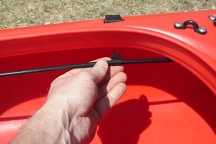
 Now
the cable tubing is sticking out of the stern and out of the cockpit
near the footwells, on both right and left sides of the kayak. Look
into the rear hatch and you should see the black tubes almost blocking
the hatch opening.
Now
the cable tubing is sticking out of the stern and out of the cockpit
near the footwells, on both right and left sides of the kayak. Look
into the rear hatch and you should see the black tubes almost blocking
the hatch opening.
You will need to install a cable holder inside to pull the tubes out of the way, one right one left. (also keeps tubes nice and tight) Use the stainless bolts and well-nuts that hold the forward hatch straps to fasten the cable holder to. You may have to swap for the long screws, so use the long ones only where you need to and the short ones where you can.
Next we anchor the ends of the tubing with cable holders.
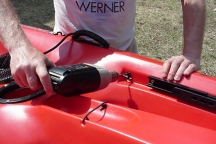
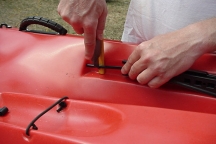 Your
Yakima rudder kit will have two large/long well-nuts. The instructions
will tell you clearly how to mount them on the stern. (On the old Aquaterra
Prism we used the large well-nuts to anchor the forward end of the tube
in the cockpit too. If you are lucky you will have extra and can use
both places.)
Your
Yakima rudder kit will have two large/long well-nuts. The instructions
will tell you clearly how to mount them on the stern. (On the old Aquaterra
Prism we used the large well-nuts to anchor the forward end of the tube
in the cockpit too. If you are lucky you will have extra and can use
both places.)
I used my large well-nuts on the stern and regular size well-nuts in the cockpit to install the cable holders. This is the best way to go, as it is very hard to reach that far back into the inside of the stern.
Trim off the excess black tube with a sharp utility knife. I used a carpenter's pencil as a backer so I would not cut into the kayak.
Leave at least a half-inch sticking out past the cable holder, or about an inch and a half of tube sticking out of the kayak.
This is a good time to mount the rudder hook. You will need it for the final steps.
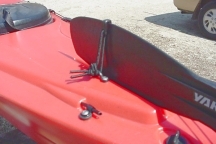 Rudder
Hook
Rudder
Hook
Your kit will come with a rudder guide, a rubber block with a V grove in the top. The Illusion does not need this piece, as it has a built in rudder guide on the back deck. You will still want to mount the hook.
I used a strap eye and fastened it with well nuts (both not included) along the built in rudder guide. (If you have an extra cable holder it will work too.) The instructions assume that you will use the rubber rudder guide and tie off the shock cord with rudder hook to it. Simply follow the instructions but tie off to the eye instead. This location is very far in the back. It may be difficult to reach for those with short arms, so the use of the self-tapping screws, included, may be an option, or rivets if you have them handy. I used well-nuts and was almost not able to reach in to tighten them, but did manage.
Install Foot Pegs
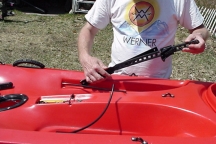 Now
it is time to mount the rudder control track. This is a metal track that
the foot peg rail/slider slips into. You will want to place the track
in the same spot you removed the keepers from.
Now
it is time to mount the rudder control track. This is a metal track that
the foot peg rail/slider slips into. You will want to place the track
in the same spot you removed the keepers from.
The directions are very clear as to what end points to the bow, but the bolting instructions are for a sit-in-side, use well-nuts to bolt it. Bolt the stern end first. Then slide the new keepers on each track.
The instructions clearly describe what end of the rail points to the bow. It will be obvious what direction by looking at the foot pegs, but pay attention non-the-less. Once you have bolted the second bolt you cannot remove the keepers without un-bolting. Then finally bolt on the bow end of the rudder control track.
(You may be inclined to use the old keepers. There is a subtle difference. The foot pegs of basic keepers have a different base. They can be trimmed with a sharp knife to accommodate the rudder control track. The keeper rail is the same. My suggestion is to set the old keepers aside and use as spares. Leave untrimmed to fit any boat, and trim only when you are ready to slip onto a rudder system. On a wilderness trip you may want to take one or two foot pegs as spares and trim in the field as necessary.)
Just as I was bolting on the last bolt to the rudder control track I ran into a little trouble. The hole was mis-aligned! The distance between the two was off by just a tad, enough to prevent mounting the metal rudder control track, but not enough to prevent mounting the flexible keeper track. (They are meant to be the same distance in bolt holes.)
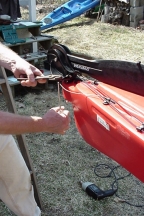
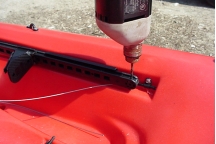 There
was only one thing to do, and that was to cut the hole larger to accommodate
the track. I used a wood carver's round gouge that matched closely the
diameter of the hole. Fortunately I did not have to cut too much, and
the flange of the well-nut seemed to cover any gap that may leak, otherwise
I would have simply smeared on some silicone to seal the hole.
There
was only one thing to do, and that was to cut the hole larger to accommodate
the track. I used a wood carver's round gouge that matched closely the
diameter of the hole. Fortunately I did not have to cut too much, and
the flange of the well-nut seemed to cover any gap that may leak, otherwise
I would have simply smeared on some silicone to seal the hole.
Next step is to slide the cables into the black tubing. Slip the free end into the rear of the tube so the eye is at the stern to attach to the rudder wings. Bolt on the cable to the wing. The instructions clearly describe this step.
Next task is to attach the cable to the keeper's plastic rail. The directions suggest using the unused bolt holes. in the back end of the rail. That is fine and will work well, but I like to drill a hole from the top of the rail, through the hole and out the bottom to orient the cable 90 degrees different than what is shown in the instructions. I feel that this will result in less wear and tear.
Next you will want to sit in the kayak and adjust the foot pedals to insure a proper fit. By far and large you need only do this if you are very tall or very short, because the peddles are adjustable to fit almost any size paddler with numerous positions. For most people you will line up the rail directly with the control track. If you are very tall or very short you may be inclined to "skew" the rail more forward (tall) or more rearward (short) but only by a little to leave room for the rail to travel back and forward. Double check that the rail placement will allow for full control of the rudder blade.
Crimp Swage
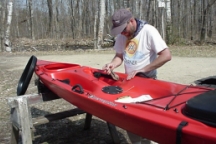 Slip
a swage, or two if you have enough, on the cable and then through the
hole in the rail. Then back through the swage. Center the rudder by locking
it down with the rudder hook. Align the rails to the control tracks as
described above. Have a friend hold the rails firmly in place while you
tighten the cables and mark the swage locations with a Sharpie marker.
Slip
a swage, or two if you have enough, on the cable and then through the
hole in the rail. Then back through the swage. Center the rudder by locking
it down with the rudder hook. Align the rails to the control tracks as
described above. Have a friend hold the rails firmly in place while you
tighten the cables and mark the swage locations with a Sharpie marker.
Then you can use your vice grips to crimp or squeeze the swage to secure the cable. Do this carefully; you will need your helper to hold the rail in place while you tighten the loop and then squeeze the swage. Look carefully to ensure that the rudder is centered and locked down, and that you are lined up with the mark made on the cable. A Rudder Cable Crimper-Cutter Tool is available at the TopKayaker Shop. However common vice grips will do the job adequately.
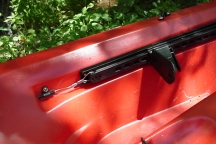 The
directions will offer some different steps that are useable. One unnecessary
step if removal of the rail. Sit-in kayaks will be difficult to access
inside the cockpit. Bear in mind that you cannot remove the rail from
the control track unless the front bolt is off. (You can if the kayak
is a sit-inside) I find that you can do the job with the rail bolted
in place, as the open cockpit design makes it very accessible.
The
directions will offer some different steps that are useable. One unnecessary
step if removal of the rail. Sit-in kayaks will be difficult to access
inside the cockpit. Bear in mind that you cannot remove the rail from
the control track unless the front bolt is off. (You can if the kayak
is a sit-inside) I find that you can do the job with the rail bolted
in place, as the open cockpit design makes it very accessible.
The next step is to cut the excess cable. The directions included describe how to cover the cut end with the swage. This will work very well. (Kit comes with 4 swages, two are extra.)
 I
used two swages on each cable, fully crimping one, cutting the excess
cable and then slipping the second swage over the cut end and crimping
the it. This covers the cut end of the cable and I feel that it will
provide the do-it-yourself job extra security to ensure the swages will
not slip if not squeezed hard enough.
I
used two swages on each cable, fully crimping one, cutting the excess
cable and then slipping the second swage over the cut end and crimping
the it. This covers the cut end of the cable and I feel that it will
provide the do-it-yourself job extra security to ensure the swages will
not slip if not squeezed hard enough.
You will want to make sure to cover any cut end with something; those stainless steel cables are like needles and can cause some pain and damage. Wrap the cut end with tape if needed. If you plan ahead you could use some small gauge shrink-wrap for a special touch.
One thing to be mindful of is that the crimping of the cables is a one-time shot! Once you have crimped there is no going back. You cannot remove the swage from the cable easily and cutting it off will leave the cable too short. They only provide one set of cables, so work slowly and with caution, fully understanding every step before squeezing those swages. If you are concerned you will screw it up you could order some extra cables and swages. If you do mess up you will have back up parts. If not than you will have spare parts in your repair kit if the cables give out in the future.
Test Your Work
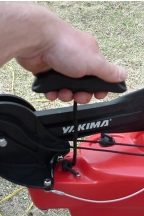 Now
the installation is complete. Do a "bench test" first to ensure
that the rudder is functioning properly and has full freedom of movement
in the rudder swing, right & left, as well as the control track travel
of the foot pegs. Also check the lift line function. Then you are ready
for "sea trials" on a short easy trip.
Now
the installation is complete. Do a "bench test" first to ensure
that the rudder is functioning properly and has full freedom of movement
in the rudder swing, right & left, as well as the control track travel
of the foot pegs. Also check the lift line function. Then you are ready
for "sea trials" on a short easy trip.
You will find that the rear grab handle is going to be mounted too short to comfortably grip when carrying with two people. If you never use the rear handle then there is no need to correct it. Most folk will want to use the rear handle.
Handles may vary from year to year. This handle is from about 2-3 years ago. Remove the cap on the top. Untie the knot. Tie a figure 8 knot onto one end and slip the other end out of the handle. Tie a figure 8 knot there and pull on the cord until you get maximum length. (You may need to pull the rope with pliers.) That should provide room for a comfortable grip. It will seem a bit long, so before going out on the water remove the rudder hook and snap it into the handle to keep it out of the way.
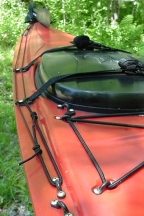 During
the installation I used well-nuts where ever possible. I did not use
any silicone, nor did I feel the need to, as well-nuts are quite water
proof. If you have drilled your screw holes tightly to the correct size,
so the screw actually cuts threads into the plastic, even the cap nuts
will be watertight. So take care not to let the drill bit "wobble"
while drilling, and do not let the screw "strip" the "threads"
in the plastic by over tightening. If you did feel the need to use rivets
for any application the use of silicone would be required.
During
the installation I used well-nuts where ever possible. I did not use
any silicone, nor did I feel the need to, as well-nuts are quite water
proof. If you have drilled your screw holes tightly to the correct size,
so the screw actually cuts threads into the plastic, even the cap nuts
will be watertight. So take care not to let the drill bit "wobble"
while drilling, and do not let the screw "strip" the "threads"
in the plastic by over tightening. If you did feel the need to use rivets
for any application the use of silicone would be required.
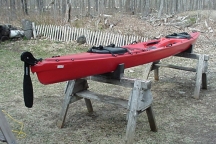 I
took my time, taking notes and photos along the way, utilizing a helper
only when needed, when I did this job. It took me about 6 hours or so.
I would guess that a well orchestrated effort, with helper of course,
would take most folks about 3-4 hours, or less.
I
took my time, taking notes and photos along the way, utilizing a helper
only when needed, when I did this job. It took me about 6 hours or so.
I would guess that a well orchestrated effort, with helper of course,
would take most folks about 3-4 hours, or less.
Any left over parts will come in handy to start filling in your kayak repair kit. Save what you think you can use. If it will not come in handy for your kayak it may be helpful for a comrade's kayak. Keep the instructions for future reference.
The Yakima (Perception) rudder kit instructions do have a technical assistance number to call if you run into any trouble. My experience, direct and indirect, has been good so far with this support. They may be able to help you out in a jamb, otherwise contact me by e-mail.
© 1998 - 2020, Tom Holtey
- All photos by author.
